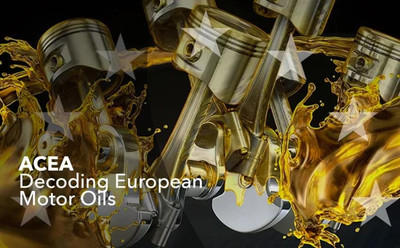
What do ACEA oil specs mean?
Ultra1Plus on Oct 26th 2025
The European Automobile Manufacturers' Association (ACEA) represents the most significant European motor vehicle manufacturers, including BMW Group, DAF, Daimler Truck, Ferrari, Ford, Honda, Hynday, IVECO Group, Jaguar - Land Rover, Mercedez-Benz, Nissan, Reanult Group, Toyota, Volkswagen Group, and Volvo. ACEA, the successor of CCMC (Comité des Constructeurs du Marché Commun), serves as an advocate for the automobile industry in Europe. Its scope encompasses manufacturers of passenger cars, vans, trucks, and buses with production sites in the EU.
Among its various endeavors, ACEA establishes specifications for engine oils known as ACEA Oil Sequences. These sequences undergo periodic updates, typically every few years, to incorporate advancements in engine and lubricant technology. While ACEA doesn't directly approve oils, it establishes the standards, enabling oil manufacturers to make performance claims for their products if they meet the relevant requirements.
Nomenclature and ACEA process:
Each set of ACEA Oil Sequences is identified for consumer use by a two-part code. The first part is a letter that defines the class or type of engine, while the second part is a number that indicates the specific performance category the oil must meet. Higher numbers signify superior performance. For example, "C2" indicates a particular performance category.
- A – oil designed for gasoline engines.
- B – oil designed for diesel engines in private cars.
- C – Designed for light engines with catalytic converters or particulate filters. Vehicles equipped with exhaust after-treatment systems, like diesel particulate filters, necessitate specialized engine oils to prevent filter clogging. These oils are categorized under the ACEA C specification, depending on the allowable proportion of ash-forming substances such as sulfated ash, phosphorus, and sulfur, and are further divided into Low and Mid SAPS oils.
- E – for commercial vehicles and trucks.
Engine oils for passenger cars are consistently designated as a combination suitable for gasoline and diesel engines, as indicated by labels such as ACEA A3/B4.
Moreover, for industrial applications, each sequence is accompanied by a two-digit number denoting the year of implementation of that severity level (e.g., A3/B4-21). A change in the year number signifies the incorporation of new tests, parameters, or limits to meet upgraded performance requirements while ensuring compatibility with existing applications. Updates must consistently meet the demands of the previous issue; otherwise, a new category is warranted.
The category indicates oils for different purposes or applications within that general class, related to some aspect or aspects of the performance level of the oil. Typical applications for each category are described in the light-duty and heavy-duty sequence documents for guidance only. Specific applications of each category are the responsibility of the individual motor manufacturer for their own vehicles and engines. Oils within one category may also meet the requirements of another category, but some engines may only be suited to oils of one category within a class.
Keep in mind that ACEA does not certify oils, license them, or issue compliance certificates. It's the responsibility of oil manufacturers to conduct all necessary testing and evaluation according to established industry standards and practices in engine lubrication. Specifically, the ACEA European Oil Sequences often reference numerous standard CEC tests.
The ACEA specifications you should be familiar with:
A3/B4: Stable, stay-in-grade engine oil intended for use at extended drain intervals in passenger car and light duty gasoline and Direct Injection (DI) diesel engines, but also suitable for applications described under A3/B3.
A5/B5: For use in passenger cars together with light duty van gasoline and diesel engines capable of using low-viscosity oils.
A7/B7: Oils have an HT/HS viscosity of 2.9 to 3.5 mPas. They offer low-speed pre-ignition and anti-wear protection for turbocharged gasoline DI engines and turbocharger compressor deposit protection for modern DI diesel engines.
C2: Oils with a Mid SAPS level (= that contain medium levels of environmentally polluting metals) where the sulfated ash content is lower than 0.8%. Those are low-friction oils with a minimum HT/HS viscosity of 2.9 cP.
C3: Oils with Mid-SAPS oils with a sulfated content lower than 0.8%. Those are low-friction and have a minimum HT/HS viscosity of 3.5 cP.
C4: Similar to C3, but for oils that contain low levels of environmentally polluting metals. They have a minimum HT/HS viscosity of 3.5 cP, while there is no lower limit on phosphorus.
C5: Also, like C3, but for engines that can use even lower (‘thinner’) viscosity oils. ACEA C5 oils are stable and provide more fuel economy. They have a lower HT/HS viscosity of 2.6-2.9 cP. with Mid-SAPS level.
C6: Stable, stay-in-grade engine oil for improved fuel economy with Mid-SAPS level, for aftertreatment system compatibility. Intended for use at extended oil drain intervals in passenger car and light duty gasoline and DI diesel engines designed and OEM approved for engine oils with HT/HS viscosity of minimum 2.6 mPas. Relative to C5, these engine oils also provide LSPI and wear protection for turbocharged gasoline DI engines as well as Turbocharger Compressor Deposit (TCCD) protection for modern DI diesel engines.
C7: Enhanced Engine Oil for Extended Oil Drain Intervals, with Mid-SAPS Level, for aftertreatment system compatibility. Intended for use at extended oil drain intervals in passenger car and light-duty gasoline & DI diesel engines designed and OEM-approved for engine oils with HT/HS viscosity of minimum 2.3 mPas. C7 is based on C6 performance levels, with the exception of enhanced fuel economy.
How to choose the right ACEA specification
Selecting the appropriate ACEA specification involves considering the unique requirements of each class and category. Using oil with an incorrect specification not only compromises your engine's performance but also risks potential damage.
Glossary:
SAPS: Sulphated Ash, Phosphorus, Sulphur
HTHS: High Temperature High Shear Viscosity
Do Ultra1Plus lubricants meet ACEA standards?
Absolutely. U1P ensures that our products consistently meet and often surpass the latest, rigorous ACEA standards.
More information about ACEA can be found on ACEA’s website.
